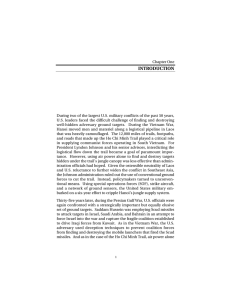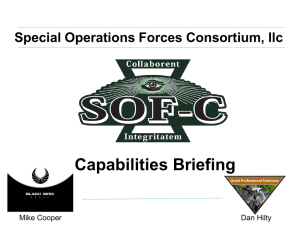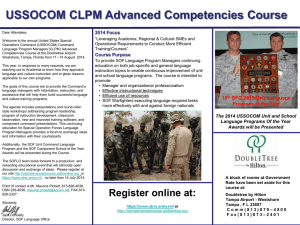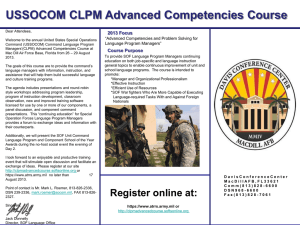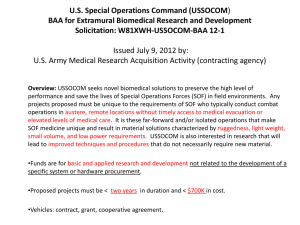CONCLUSIONS AND IMPLICATIONS FOR FUTURE OPERATIONS
advertisement
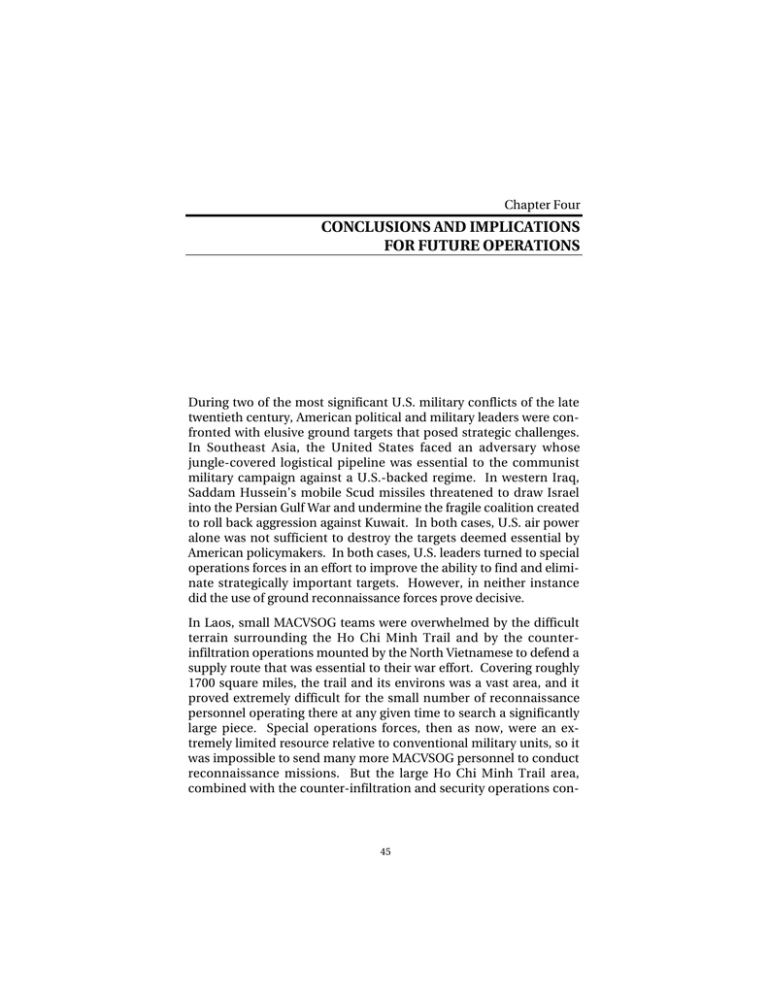
Chapter Four CONCLUSIONS AND IMPLICATIONS FOR FUTURE OPERATIONS During two of the most significant U.S. military conflicts of the late twentieth century, American political and military leaders were confronted with elusive ground targets that posed strategic challenges. In Southeast Asia, the United States faced an adversary whose jungle-covered logistical pipeline was essential to the communist military campaign against a U.S.-backed regime. In western Iraq, Saddam Hussein’s mobile Scud missiles threatened to draw Israel into the Persian Gulf War and undermine the fragile coalition created to roll back aggression against Kuwait. In both cases, U.S. air power alone was not sufficient to destroy the targets deemed essential by American policymakers. In both cases, U.S. leaders turned to special operations forces in an effort to improve the ability to find and eliminate strategically important targets. However, in neither instance did the use of ground reconnaissance forces prove decisive. In Laos, small MACVSOG teams were overwhelmed by the difficult terrain surrounding the Ho Chi Minh Trail and by the counterinfiltration operations mounted by the North Vietnamese to defend a supply route that was essential to their war effort. Covering roughly 1700 square miles, the trail and its environs was a vast area, and it proved extremely difficult for the small number of reconnaissance personnel operating there at any given time to search a significantly large piece. Special operations forces, then as now, were an extremely limited resource relative to conventional military units, so it was impossible to send many more MACVSOG personnel to conduct reconnaissance missions. But the large Ho Chi Minh Trail area, combined with the counter-infiltration and security operations con- 45 46 Special Operations Forces and Elusive Enemy Ground Targets ducted by the 25,000 North Vietnamese troops deployed along the trail, created insurmountable tactical and operational hurdles for MACVSOG. To be sure, the ground reconnaissance teams could point to a number of successes. They gathered intelligence on the enemy, captured prisoners, and conducted bomb damage assessments of critical targets. More important, they succeeded in taking the war to the adversary. MACVSOG operations reduced the trail’s role as a sanctuary and safe haven for PAVN forces and compelled Hanoi to expend resources to defend the strategic lifeline. However, with respect to OP 35’s primary mission—finding targets and calling in air strikes—success proved much more elusive. This is not to say that the SHINING BRASS/PRAIRIE FIRE teams failed to locate key targets. However, the strike aircraft called in to destroy trucks, vehicle shelters, and roads had great difficulty in hitting enough targets to affect North Vietnam’s ability to wage war. The logistical requirements for communist forces operating in South Vietnam were tiny compared to those of the United States. To keep Hanoi’s forces supplied, only a handful of North Vietnamese trucks needed to escape the American ground-sensor network, reconnaissance teams, and strike aircraft on any given day. The challenges posed by the mobile TELs in western Iraq were in some respects even more daunting. The area in which they operated—29,000 square miles of desert—was significantly larger than the Ho Chi Minh Trail and its environs. Satellite and other overhead reconnaissance was unable to locate the mobile launchers with any precision, so the U.S. and British ground SOF were forced to conduct wide-area surveillance for the TELs. As in Southeast Asia, camouflage and other deception techniques were a major part of the adversary’s tactics and procedures. Iraqi deception, combined with shortfalls in coalition aircraft sensors and other technical problems, made it extremely difficult for strike aircraft to destroy the targets identified by the SOF personnel on the ground. The combined airground operations may have resulted in the destruction of some mobile TELs, but it seems likely that the number was small and well below what DoD officials had originally claimed. Thus, as in the case of the campaign against the Ho Chi Minh Trail, the air-ground operations in the Persian Gulf failed to achieve their Conclusions and Implications for Future Operations 47 tactical and operational objectives. However, there was one important difference with respect to their relative effectiveness. As noted by Colin Gray, “the definition of success for special operations is not straightforward. Tactical failure at the right time, in the right way, and for the right reasons can amount to strategic success.”1 At the tactical and operational level, the American and British forces succeeded in little more than harassing Iraqi mobile TEL crews. At the strategic level, however, SOF, in helping to persuade the Israelis not to enter the war and rupture the coalition, achieved their primary objective. Dramatic improvements in sensors, communications, and other technology since the time of the Ho Chi Minh Trail and Persian Gulf campaigns raise the question of whether these missions, if conducted using modern equipment, would be any more successful than they were in the past. Although the communications systems employed by MACVSOG personnel in Laos were state of the art in contemporaneous terms, advances in radios, satellite communications, burst-transmission devices, and electronic repeaters would make it much easier for ground teams to remain in continuous contact with forward air controllers.2 Reconnaissance teams, whether hunting for targets in a jungle environment or in the desert, could also call upon new and improved imaging devices, such as third-generation night vision goggles (NVGs) and thermal-imaging systems. The latest NVGs permit military personnel to positively identify objects at twice the range that was possible during the Scud hunt.3 In addition, crews aboard aircraft that could be used to interdict ground targets, such as A-10s, are now NVG-capable. Thermal-imaging systems have also improved dramatically, with an effective range of up to 5000 meters, roughly five times greater than those employed during Operation Desert Storm.4 That said, however, a number of major hurdles are likely to continue to hamper operations against elusive ground targets. In a hostile or ______________ 1Gray, “Handfuls of Heroes.” 2Churchill, “Interview with Bowra,” p. 12. 3Author’s interviews with service personnel at 24th Special Tactics Squadron, Pope AFB, May 31, 2000. 4Author’s interview with Stephan. 48 Special Operations Forces and Elusive Enemy Ground Targets denied country, finding and identifying mobile objects that have been obscured by foliage or by deception, or are simply dispersed in vast areas like western Iraq, remain beyond the capability of even the most sophisticated reconnaissance sensors. 5 Because of their relatively high cost, such sensors and their platforms are also likely to remain scarce, as JSTARS and the TR-1/U-2R were during the Persian Gulf War.6 SOF personnel, almost by definition, also are likely to remain in short supply, which would pose a major obstacle if they were called upon to search large areas for mobile TELs or other highvalue targets. Nevertheless, it is possible to imagine a future role for SOF in finding elusive enemy ground targets. In cases where it is imperative that a strategically important target—such as a nuclear, biological, or chemical weapon or production facility in a hostile or denied area— be destroyed with absolute certainty, it may be worth considering deploying SOF to conduct the mission. Advances in technology could make it safer and easier for SOF to carry out such operations in the future. For example, mini– and micro–unmanned aerial vehicles could allow ground reconnaissance to search far larger areas than they could from vehicles or on foot, and with far less risk of discovery by adversary forces.7 Two other potential SOF roles could enhance the ability of the United States to find and destroy elusive targets on the ground. Although BDA was never more than a collateral mission for SOF during the Vietnam and Persian Gulf conflicts, it could play a larger role in the future in operations involving strategically important targets, such as ballistic missiles and their supporting infrastructure. After suspected sites have been subjected to air attack, ground teams could survey the damaged areas and provide visual confirmation that the target had been destroyed. Such “policing of the battlefield” by SOF might also include scouring the attacked site and securing any ______________ 5 CDISS, “Implications for the Future,” n.d., accessed at http://www.cdiss.org/ scudnt8.htm. 6CDISS, “The Great Scud Hunt: An Assessment.” 7 “Prospects for Unmanned Aerial Vehicles,” Strategic Comments, International Institute for Strategic Studies, Vol. 6, No. 7, September 2000, p. 2. Conclusions and Implications for Future Operations 49 operable missile warheads or components that could still be used by the adversary or make their way to sale on the black market.8 Finally, SOF ground personnel could play a role in what during the Vietnam era was termed the “electronic battlefield.” As was the case with BDA, emplanting unattended ground sensors (UGS) was a secondary mission for SOF during operations on the Ho Chi Minh Trail. In the future, however, Air Force personnel may rely heavily on UGS to identify adversary ground targets in terrain that is difficult to survey using airborne reconnaissance sensors. As with IGLOO WHITE, most of the UGS currently under development are air-delivered. Some UGS, however, may have to be carried into the surveillance area and put into place by hand.9 In built-up areas, for example, dropping even well-camouflaged UGS from the air would make little sense, since there would be a great likelihood that the local population or adversary forces would detect them. Imaging UGS in particular are likely to require emplacement by hand. If dropped from the air, these devices, which require a clear line of sight to their targets, could have their field of vision obscured by a rock, tree branch, or other obstruction. In addition, imaging UGS are likely to be fairly delicate instruments that would be damaged if delivered from jet aircraft moving over the ground at hundreds of miles per hour. Even these more limited roles, however, will carry with them potentially high political costs. Given the obstacles associated with the earlier use of SOF, policymakers must bear in mind that even relatively small-scale missions to find elusive targets entail great risk of failure. Strategic special operations are by definition high risk, and SOF failures (as in the failed 1980 Iranian hostage rescue mission) tend to be both spectacular and politically costly.10 During the missions against the Ho Chi Minh Trail and the Iraqi mobile TELs, political and military leaders were rightly concerned about the damage caused if these covert and clandestine operations ______________ 8Wirtz, “A Joint Idea,” p. 92. 9This section relies heavily on information gathered during the author’s conversations with RAND analysts Rich Moore and John Stillion. 10Lucien S. Vandenbroucke, Perilous Options: Special Operations as an Instrument of U.S. Foreign Policy, Oxford University Press, New York and Oxford, 1993, p. 4. 50 Special Operations Forces and Elusive Enemy Ground Targets were exposed.11 Such concerns will carry forth to any future operations involving the use of SOF to find elusive ground targets. In the future, however, political and military leaders will have to grapple with an additional burden. It is a truism that Western public opinion has become deeply averse to casualties—among their own forces, civilian populations in war zones, and even among adversary forces. Today, it is also true that the citizens of the Western democracies are deeply troubled by the capture of friendly military personnel. Prisoner-of-war aversion may now be as deeply ingrained as casualty aversion. Political and military leaders will have to bear this new domestic political factor in mind as they weigh the costs and benefits of deploying ground observers in hostile or denied areas. ______________ 11 See for example, memorandum from Unger to Katzenbach, December 2, 1966, FRUS, 1964–1968, Vol. 27, Laos; de la Billière, Storm Command, p. 223.
